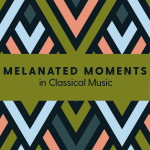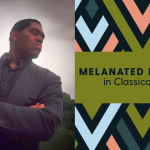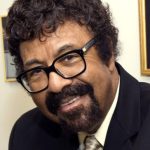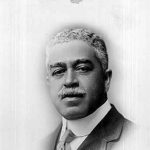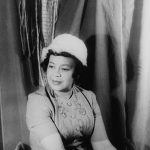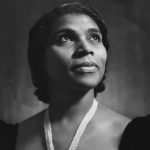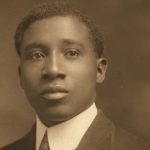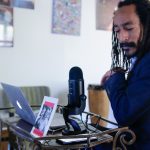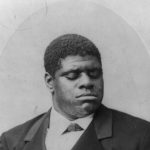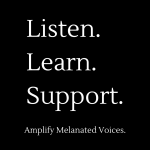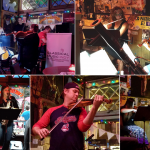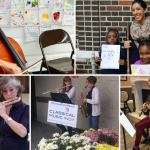MMCM S4E6: Julia Perry: A Prelude in Postmodernism
Joshua familiarizes us with the short but exceptional life of composer Julia Perry. He and Angela explore the meaning of postmodernism in connection with Perry’s compositional evolution from traditional to postmodern stylings. A two-time recipient of the prestigious Guggenheim Fellowship, Perry studied with the renowned Madame Nadia Boulanger in France, composed despite multiple strokes and significant health challenges, and had her music recorded by the New York Philharmonic in 1965.
Featured Music:
“Free At Last,” arranged by Julia Perry, performed by vocalist Robert Honeysucker and pianist Vivian Taylor
“Prelude No. 1 for piano,” performed by Allegra Chapman
“Short Piece for Orchestra,” performed by the Imperial Philharmonic of Tokyo
Angela Brown (00:00): Before we get started with this episode, we wanted to thank our listeners for your amazing support of this podcast. We can’t wait to bring you future episodes, but we need your support. Just go to givebutter.com/melanatedmoments to help share more stories of exceptional Black artists with thousands of listeners across the US and around the world. Joshua Thompson (00:27): And if you’d like more information on each episode, go to our website or follow us on social media. Angela Brown (00:33): Follow my foundation on Facebook @MorningBrown or on the web at morningbrown.org. Joshua Thompson (00:41): And follow me Joshua Thompson on Instagram @SockJoplin. Angela Brown (01:01): Hey everybody, and welcome back to another episode of Melanated Moments in Classical Music. I’m Angela Brown. Joshua Thompson (01:09): And I’m Joshua Thompson. Angela, today we’re going to discuss a composer who is often left out of the artistic conversation despite winning two Guggenheim fellowships, being a breakout composer by the age of 27, and an unwitting yet key figure in the postmodern arts movement. Angela Brown (01:31): Hmm. Sounds like we’ve got another case of melanated mastery hiding in plain sight. Joshua Thompson (01:37): [Laughter] Angela Brown (01:37): Well, don’t keep me or the people’s waiting. Who is it? And what is postmodernism? Joshua Thompson (01:44): Well, today helping us frame and define postmodernism, we’re talking about Julia Perry. Angela Brown (01:51): Oh, alright now! You seem really excited, so walk us through the melanated stuff and things, Mr. Joshua. Joshua Thompson (01:59): Yes ma’am, let’s get to walkin’! First things first, here’s a little background on Julia Perry. Born in Lexington, Kentucky in 1924, Julia Perry was an American classical composer and teacher who combined European classical and neoclassical training with the cultural and musical roots of her African American heritage. She studied voice, piano, and composition at the Westminster Choir College from 1943 to 48, where she earned her bachelor’s and her masters. Then continued her graduate studies at Berkshire music center in Tanglewood and later studied at the Julliard School of Music in 1952, also the same year that she won her first Guggenheim fellowship. And she used that fellowship to travel to Paris and study under the famed Nadia Boulanger. And she did pretty well with Nadia Boulanger. She was awarded the Boulanger Grand Prix for her Viola Sonata, and then she gets her second Guggenheim fellowship in 1954. So like two years later, she’s collecting another one. Angela Brown (03:05): Hey! Joshua Thompson (03:05): Stunning. Yeah, yeah, yeah. So what what’s interesting about Julia Perry is she is the perfect evolution of an artist and a composer. Uh, and we’ll hear a lot of this because her early compositions are heavily influenced by African American music while her later works, really exhibit her branching out in compositional technique and experimenting with dissonance. Like, as I told my students leading into the crunchy sounds, right? So she’s really into, into all of that, but her compositions didn’t really rise to fame, I’d say broadly until about the late 1960s. And in 1971, um, after a series of strokes, Julia Perry lost her ability to write with her right hand. Angela Brown (03:53): Mhmm. Joshua Thompson (03:53): However, you know, how stubborn and passionate artists are. She did not let that stop her at all. She actually taught herself how to write with her left hand. Angela Brown (04:02): Alright now! Joshua Thompson (04:03): So she could keep on- Angela Brown (04:05): Can’t keep a good woman down… Joshua Thompson (04:06): Ain’t that it! So she could keep writing. So she teaches herself how to write all over again. And she has a, a whole history and a catalog of several works for chamber orchestra, full orchestra, choral works, concertos, symphony and operas, and while her works were not wildly recorded, her “Short Piece for Orchestra,” which we’ll listen to later, was performed and recorded by the New York Philharmonic in 1965 in the Lincoln Center. And so just a prolific career, uh undersung and under celebrated, but, you know, she continued to have health problems and unfortunately, after a few to several more strokes, she was unable to compose and, and she eventually did die at the age of 55. Angela Brown (04:52): Oh my goodness. Such a short life, but an exceptional one. I, I may be jumping the gun a little bit, but you mentioned a branching out in her compositional style. Joshua Thompson (05:06): Mhmm. Angela Brown (05:06): Branching out from what exactly? Can you let us hear an example? Joshua Thompson (05:11): Absolutely, of course. And your question is right on time. I, I, well, ’cause you know, I was talking too much anyway, so, uh, we’re gonna hear a, a couple things here. Uh, and so let’s listen to the music first and then we’ll kind of break this down from this like branching out, right? Angela Brown (05:27): Okay. Joshua Thompson (05:27): We’re gonna listen to “Free at Last,” which was written in 1951. And I think this is a wonderful example to kind of discuss the beginning of her evolution as a composer and a person because she starts out continuing in the tradition and arguably at this point, the well established tradition of Black people incorporating spirituals into the cannon of classical music. So from the 1951 composition, this is “Free at Last.” Music Plays (06:02): [“Free At Last” traditional spiritual arranged by Julia Perry, performed by vocalist Robert Honeysucker and pianist Vivian Taylor] Angela Brown (08:26): This is really beautiful Joshua, but I think this is an arrangement of a spiritual, not an art song. Joshua Thompson (08:33): Mhmm. Angela Brown (08:34): Because there were no spirituals that were composed after the 6,000 spiritual melodies that we know about, but she did a beautiful arrangement of this spiritual. Joshua Thompson (08:47): Yeah. And, and, and thank you for that. That is a necessary and good clarifying point, but this is kind of where she’s starting from as a composer, right? The pedagogy. Angela Brown (08:57): Yeah. Joshua Thompson (08:57): The sourcing of spirituals and then using them in a new form. Well, it’s somewhat in a new format, right? So, you know, and this is written in 1951, which is a really significant year for Perry because this is her breakout year as being known as a prominent and composer to watch for in this same year, she composes this epic vocal tone poem, Stabat Mater, it’s like 19, 20 minutes. Um, and this piece blew the artistic community away. I mean, if you remember her fell- her Guggenheim fellowship comes the following year and it’s because of Stabat Mater, um, that she’s awarded that primarily because of the piece’s stunning display of compositional voicings with dissonance tension and neoclassicism, right. So that’s where she’s going from Free at Last, she’s writing lyrical art songy, spiritual type things, but all the while behind the scenes, she’s composing breakout compositions that’re about to floor the entire artistic community. Angela Brown (10:06): Yeah, ’cause it seems like a lot of composers of that era, they use the spiritual as a conduit, as a stepping stone- Joshua Thompson (10:15): Very much. Angela Brown (10:15): In, into composing other genres of music and being able to, to arrange a spiritual is just- seems to be par for the course. So in a few words as possible, Joshua… Joshua Thompson (10:28): [Laughter] Angela Brown (10:28): Help us understand if you can… Help us understand how this woman helps to usher in the post modern arts movement. Actually… Let me back up. What’s postmodernism again? Joshua Thompson (10:43): Okay. Well, so in as few words as possible, wish me luck. Unison (10:47): [Laughter] Joshua Thompson (10:49): Postmodernism, it’s, it’s pretty difficult to define, uh, primarily because to define it would to would, would violate the postmodernist premise that there are no definite terms. There are no definite boundaries or absolute truths, right? However, for the sake of clarity, postmodernism really seeks to challenge traditional and established modes, methods and, and resolutions, whether in intentional defiance of convention or as a means to express alternative ways to construct and deconstruct systems and structures in art, and literature, and music, philosophy, politics, and on and on and on. Right? So post modernism really relies on, uh, a critical eye and ear to theory, uh, because it really considers the effects, the after effects of any given ideology, any tenant of a society history or culture. Angela Brown (11:46): Okay. That sounds very counterculture to me. Joshua Thompson (11:52): Well, okay. So it’s funny you say that because it is, and it’s still not a clear definition. I realized that. Angela Brown (11:56): [Laughter] Joshua Thompson (11:56): Right? Angela Brown (11:58): Clear as mud, baby, clear as mud! Joshua Thompson (12:00): Clear as mud. So it, the term post modernism, it it’s kind of first used ubiquitously in the 1970s to describe musical, artistic, and literary and philosophical trends that began early as the 1940s. Angela Brown (12:16): Okay. So this is art post World War II to the present. Am I correct? Joshua Thompson (12:23): You- indeed, you are. And there are several illustrations of post modernism that we all know, but we never really associate with the term. Angela Brown (12:30): Like what? Joshua Thompson (12:31): Okay. So think about the Golden Age of Hollywood. Think about the Harlem Renaissance. Um, a good one would be like beatnik culture of Jack Kerouac and Greenwich Village like this whole rebel-without-a-cause thing, Andy Warhol’s pop art movement and the actual Black arts movements of the 1960s and 70s. These are all illustrations and reflections of postmodernism. Angela Brown (12:55): Okay. Okay. So artistically, politically and socially, this is such a tense dynamic and revolutionary time period. Joshua Thompson (13:06): You know, it really is. And to have the ability to set all of that to music, I find to be pretty astounding. So we’ve done enough talking and I still have not made my point very clear, but Julia Perry did it for us. And so let’s hear a quick example of this postmodern aesthetic. And I love this piece so much. Oh my God. I love it. I went out and I bought the music ’cause I was like, I’m gonna play this. Um, let’s listen to Julia Perry’s prelude number one. Music Plays (13:34): [Julia Perry’s “Prelude No. 1 for piano” performed by Allegra Chapman] Angela Brown (15:27): Okay. Yeah, I can hear, and I can hear you playing this. This is the kind of music you like. Joshua Thompson (15:31): [Laughter] Angela Brown (15:31): ‘Cause it sounded like a whole lot of non-modulatory modulations going somewhere. Unison (15:37): [Laughter] Angela Brown (15:37): And I guess it ended up there, but it’s nice. It’s very, uh, broody, moody, and rich and lush. Joshua Thompson (15:45): Yeah. You know, I like it too. I love how you say it is going somewhere. And uh, she does a wonderful job of providing- your giggle was hilarious. You’re like, okay baby. Uh, she, she does a wonderful job of providing this atmospheric richness. Angela Brown (16:00): Yeah. Joshua Thompson (16:01): But she keeps the listener on alert with that use of dissonance. Like, typically at this point, most of the times, our ear is trained to listen to, you know, like parallel fifths, right? We like resolution, she’s changing it up. She’s not doing that. She’s using a lot of thirds and fourths, which kind of puts that ping in your ear and makes you sit on the edge for that resolution. And she’s like, I’m not giving you- Angela Brown (16:27): I’m not going there, exactly. Joshua Thompson (16:29): She’s not because this is not the period that has nice clean, uh, you know, resolutions, we’re in a post modern society where things are a little bit unresolved sometimes. Angela Brown (16:39): So Joshua, how does this music differ from what we consider to be new music in classical music? Joshua Thompson (16:46): You know, there are probably those who would like vehemently argue with me on this and you’re welcome to, but honestly, in my opinion, I, it really doesn’t differ at all. I don’t think because postmodern music, minimalism, surrealism, new music, whatever you wanna call it. These are all fairly synonymous and interchangeable with regards to the components of the music based on, you know, the time period that we’re in. And honestly like the motivations of not just Julia Perry, but other literary, artistic, theatrical, musical artist of the time. Angela Brown (17:18): Well, Mr. Joshua, could you give us another example of her work that really highlights the postmodernist sound? Joshua Thompson (17:26): Absolutely. And I, and I promise this one’s really going to stretch the ear out of a lot of folks. And so I, I, I highly encourage everyone- Angela Brown (17:33): Is it gonna resolve? [Laughter] Joshua Thompson (17:35): Well, I don’t think it’s gon- like I would say lean into the crunchy, breathe into the crunchy, right? Angela Brown (17:40): Okay baby. Okay, okay, okay. Unison (17:41): [Laughter] Joshua Thompson (17:42): So lemme say that before you- we’re gonna listen to her Short Piece for Orchestra. This is the first composition by a woman of color to be performed by the New York Philharmonic. And so the piece itself starts out somewhat frantic and wild, right? With the strings and the brass section, switching between background and foreground in this composition. So it’s riveting, it’s exciting. And there’s this rhythmic fill from the percussion that just really… I don’t know, like we have to hear it because- Angela Brown (18:13): Well then let’s hear it! Joshua Thompson (18:13): Okay, then I’ll, I’ll stop talking. Let’s listen to- Unison (18:16): [Laughter] Joshua Thompson (18:16): To her Short Piece for Orchestra. Music Plays (18:19): [Julia Perry’s “Short Piece for Orchestra” performed by the Imperial Philharmonic of Tokyo] Angela Brown (20:54): I have to be honest, Joshua, I love the beginning of that. It reminded me of West Side Story. Joshua Thompson (21:00): Yeah! Angela Brown (21:01): You know, some Bernstein snatches in there. Joshua Thompson (21:05): Mhmm, mhmm. Angela Brown (21:05): And sometimes this genre of music is a little hard for me to get into, but given the context, my listening experience was a little different this time. Joshua Thompson (21:14): Like how so? Angela Brown (21:16): I listened to it this time like I would a film score, like one of those blockbuster hits. Joshua Thompson (21:23): Yes, yes, yes! And, you know, hey, whatever works, whatever works. And you’re, I absolutely right to mention Leonard Bernstein with his West Side Story, I would think on the waterfront, right? All these like modern cinematic thrillers that have these gripping, you know, movie scores. I think that’s a wonderful way to come at this piece, not just for you, but for any listener, uh, is to do that. And Perry’s catalog truly were represents a composer who seriously considered what music should and could be. Angela Brown (21:54): You know, it’s always the forward thinking that keep anything and everything in perpetual motion. Joshua Thompson (22:01): And ain’t that it, like seriously. Uh, so ahead of her time for sure. Of her time, but ahead of it, before we sign off, I wanted to read an artist statement of sorts from, from Julia Perry and it’s from 1949. And I think this does a wonderful job of perhaps simplifying the complexities of modernism and life itself as, as told by Julia Perry. She says: “Music is an all embracing universal language. Music has a unifying effect on the peoples of the world because they all understand and love it. And music, they find common meeting ground, and when they find themselves enjoying and loving the same music, they find themselves loving one another. Music has a great role to play and establishing the brotherhood of man.” Angela Brown (22:55): I can’t think of a better quote to leave with our listeners to marinate over until the next time. So, I’m Angela Brown. Joshua Thompson (23:02): And I’m Joshua Thompson. Unison (23:05): And this has been Melanated Moments in Classical Music. Angela Brown (23:16): Melanated Moments in Classical Music is a production of Classical Music Indy. Our producers are Ezra Bakker, Trupiano and Adam Fonacier. Our theme music was composed by Laura Karpman. Joshua Thompson (23:31): Melanated Moments in Classical Music is made possible in part by the Indiana Arts Commission, a state agency, and the National Endowment for the Arts, a federal agency. Additional support comes from the Indy Arts Council and the City of Indianapolis. Angela Brown (23:46): Our podcast partners are Morning Brown, Inc. and Symphony Tacoma.
[/su_tab] [su_tab title=”Related Blog Posts” disabled=”no” anchor=”” url=”” target=”blank” class=””]LOCAL CLASSICAL – MELANATED MOMENTS SEASON SIX
As we continue celebrating Black Music Month, this week’s playlist will feature music and artists discussed during the latest season of Melanated Moments in Classical Music. All of season six was recently released and featured vibrant discussions about artists such as Scott Joplin, Hazel Scott, Joseph Bologne, and Kenneth Overton, among others.
LOCAL CLASSICAL – BLACK MUSIC MONTH
In this week’s playlist, we celebrate Black Music Month which takes place in June. It was created by President Jimmy Carter in 1979 to honor and celebrate Black artists’ contributions to music. We’ll be honoring the late Herman Whitfield III, an Indianapolis native who was a gifted pianist and composer. We’ll also hear performances of artists who have been featured in season four of Classical Music Indy’s podcast, Melanated Moments in Classical Music.
LOCAL CLASSICAL – MELANATED MOMENTS
In this week’s Black History Month playlist, we bring you recordings by composers, performers, and artists who have been highlighted in our podcast, Melanated Moments in Classical Music. Melanated Moments is the ward-winning podcast from Classical Music Indy that shines a spotlight on musical works composed by, for, and about Black people.
Ric’key Pageot: Inspiring a Moment to Learn, Acknowledge, and Respect
Ric’key Pageot: Inspiring a Mo …
Ignatius Sancho: Composing the Hypocrisy of Colonialism & Convention
Ignatius Sancho: Composing the …
NEW CLASSICAL – DR. BILL BANFIELD
This week we bring you the music of Dr. Bill Banfield. Dr. Banfield is an award-winning composer whose symphonies, operas, chamber works have been performed and recorded by major symphonies across the country. Few have a wider, performed professional composing output, that has had public concert performances, reviews, radio, recordings of some 12 symphonies, 7 opera, 9 concerti, chamber, jazz, and popular forms. This alone making Dr. Banfield one of the most performed, recorded composers of his generation. In 2010 and 2016, Dr. Banfield served as a Pulitzer Prize judge in American music.
#AmplifyMelanatedVoices
Classical Music Indy stands with our Black community. We are here to listen, learn, and lend our support. We believe that classical music is powerful; that it evokes a range of human emotions and creative expression.
Angela Brown Brings her Unbridled Zeal to a New Podcast.
Angela Brown brings her unbrid …
Local Classical – Angela Brown
We continue our Black History Month programming this week with our featured artist, soprano Angela Brown. Born in Indianapolis, Brown has led a world-renowned career as a vocal soloist. Her highly successful Metropolitan Opera debut in the title role of Aida captured instant attention from international print and broadcast media and catapulted Angela onto the world’s prestigious opera and symphonic stages.
A Chorus of Opposition After Segregated Concert
For our first blog post during Black History Month, we wanted to take a look at a time in American history when the simple act of attending a classical music concert was prohibited for people of color. Renowned African-American opera baritone Robert Honeysucker, who unexpectedly died in 2017, was a student at Tougaloo College in 1963 when he decided to attend a whites-only concert in Jackson, Mississippi. His actions and the many other brave protests of the Civil Rights Movement helped to shed light on the issue of racial prejudice, but how far has classical music really come today?
Highlighting our Female Performers
Classical Music Indy employs a diverse range of musicians for our events around Indianapolis. In 2016 we hired 95 musicians. Classical Music Indy has dedicated our blog articles to outstanding women musicians this month. We’ve shared about great women music educators in America and about under-recognized women musicians throughout history. This week, we take a look at a few of Classical Music Indy’s top performers – women who are doing great work here and now in the city of Indianapolis. Read below about these incredibly talented musicians, and hopefully you’ll hear them at one of our events in the near future!

